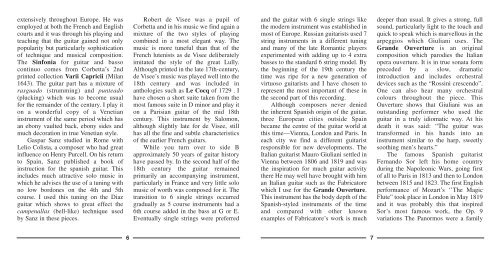GUITAR COLLECTION - The Classical Shop
GUITAR COLLECTION - The Classical Shop
GUITAR COLLECTION - The Classical Shop
Create successful ePaper yourself
Turn your PDF publications into a flip-book with our unique Google optimized e-Paper software.
extensively throughout Europe. He was<br />
employed at both the French and English<br />
courts and it was through his playing and<br />
teaching that the guitar gained not only<br />
popularity but particularly sophistication<br />
of technique and musical composition.<br />
<strong>The</strong> Sinfonia for guitar and basso<br />
continuo comes from Corbetta’s 2nd<br />
printed collection Varii Capricii (Milan<br />
1643). <strong>The</strong> guitar part has a mixture of<br />
rasguado (strumming) and punteado<br />
(plucking) which was to become usual<br />
for the remainder of the century. I play it<br />
on a wonderful copy of a Venetian<br />
instrument of the same period which has<br />
an ebony vaulted back, ebony sides and<br />
much decoration in true Venetian style.<br />
Gaspar Sanz studied in Rome with<br />
Lelio Colista, a composer who had great<br />
influence on Henry Purcell. On his return<br />
to Spain, Sanz published a book of<br />
instruction for the spanish guitar. This<br />
includes much attractive solo music in<br />
which he advises the use of a tuning with<br />
no low bordones on the 4th and 5th<br />
course. I used this tuning on the Diaz<br />
guitar which shows to great effect the<br />
campenallas (bell-like) technique used<br />
by Sanz in these pieces.<br />
Robert de Visee was a pupil of<br />
Corbetta and in his music we find again a<br />
mixture of the two styles of playing<br />
combined in a most elegant way. <strong>The</strong><br />
music is more tuneful than that of the<br />
French lutenists as de Visee deliberately<br />
imitated the style of the great Lully.<br />
Although printed in the late 17th-century,<br />
de Visee’s music was played well into the<br />
18th century and was included in<br />
anthologies such as Le Cocq of 1729 . I<br />
have chosen a short suite taken from the<br />
most famous suite in D minor and play it<br />
on a Parisian guitar of the mid 18th<br />
century. This instrument by Salomon,<br />
although slightly late for de Visee, still<br />
has all the fine and subtle characteristics<br />
of the earlier French guitars.<br />
While you turn over to side B<br />
approximately 50 years of guitar history<br />
have passed by. In the second half of the<br />
18th century the guitar remained<br />
primarily an accompanying instrument,<br />
particularly in France and very little solo<br />
music of worth was composed for it. <strong>The</strong><br />
transition to 6 single strings occurred<br />
gradually as 5 course instruments had a<br />
6th course added in the bass at G or E.<br />
Eventually single strings were preferred<br />
and the guitar with 6 single strings like<br />
the modern instrument was established in<br />
most of Europe. Russian guitarists used 7<br />
string instruments in a different tuning<br />
and many of the late Romantic players<br />
experimented with adding up to 4 extra<br />
basses to the standard 6 string model. By<br />
the beginning of the 19th century the<br />
time was ripe for a new generation of<br />
virtuoso guitarists and I have chosen to<br />
represent the most important of these in<br />
the second part of this recording.<br />
Although composers never denied<br />
the inherent Spanish origin of the guitar,<br />
three European cities outside Spain<br />
became the centre of the guitar world at<br />
this time—Vienna, London and Paris. In<br />
each city we find a different guitarist<br />
responsible for new developments. <strong>The</strong><br />
Italian guitarist Mauro Giuliani settled in<br />
Vienna between 1806 and 1819 and was<br />
the inspiration for much guitar activity<br />
there He may well have brought with him<br />
an Italian guitar such as the Fabricatore<br />
which I use for the Grande Ouverture.<br />
This instrument has the body depth of the<br />
Spanish-styled instruments of the time<br />
and compared with other known<br />
examples of Fabricatore’s work is much<br />
6 7<br />
deeper than usual. It gives a strong, full<br />
sound, particularly light to the touch and<br />
quick to speak which is marvellous in the<br />
arpeggios which Giuliani uses. <strong>The</strong><br />
Grande Ouverture is an original<br />
composition which parodies the Italian<br />
opera ouverture. It is in true sonata form<br />
preceded by a slow, dramatic<br />
introduction and includes orchestral<br />
devices such as the “Rossini crescendo”.<br />
One can also hear many orchestral<br />
colours throughout the piece. This<br />
Ouverture shows that Giuliani was an<br />
outstanding performer who used the<br />
guitar in a truly idiomatic way. At his<br />
death it was said: “<strong>The</strong> guitar was<br />
transformed in his hands into an<br />
instrument similar to the harp, sweetly<br />
soothing men’s hearts.”<br />
<strong>The</strong> famous Spanish guitarist<br />
Fernando Sor left his home country<br />
during the Napoleonic Wars, going first<br />
of all to Paris in 1813 and then to London<br />
between 1815 and 1823. <strong>The</strong> first English<br />
performance of Mozart’s ‘’<strong>The</strong> Magic<br />
Flute” took place in London in May 1819<br />
and it was probably this that inspired<br />
Sor’s most famous work, the Op. 9<br />
variations <strong>The</strong> Panormos were a family



